May 20, 2015
By David Draper
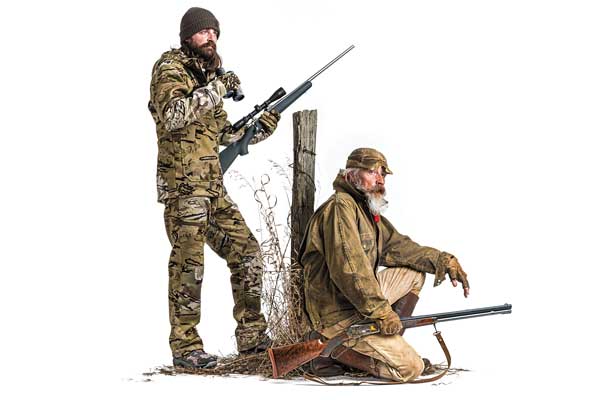 In a world where boys can no longer be boys and pointing a finger on the playground gets a kid kicked out of school, it's hard to argue with old-timers who say we're raising a generation of wimps.
In a world where boys can no longer be boys and pointing a finger on the playground gets a kid kicked out of school, it's hard to argue with old-timers who say we're raising a generation of wimps.
Even in the woods, it's easy to believe we've lost our edge when gadgets have trumped experience. But were the good old days really so good?
We're tagging more and bigger deer than ever before, and we're doing it in less time in the woods. Ah, there's the crux — modern man has become a better killer, but are we really better hunters? Let's take a look at seven essential skills and see who's really doing it better.
Advertisement
Orienteering
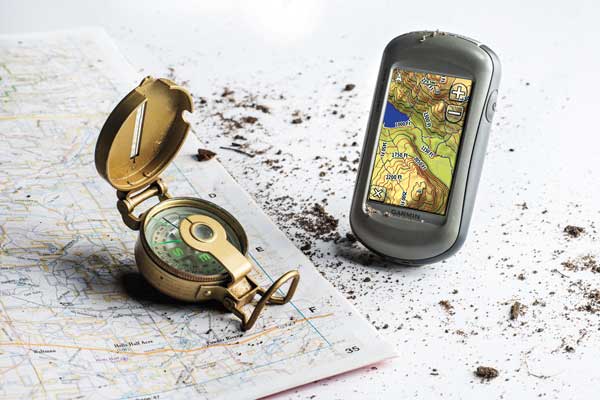 Map & Compass
Map & Compass
With a quick glance at his topographic map, the hunter schooled in traditional orienteering sees not just squiggly lines on paper, but mountain peaks, deep canyons, and wide saddles where he's likely to find elk.
Advertisement
He understands scale and minutes and how close the contour lines lay tells him he must be ready to climb steep grades or navigate around sheer cliffs. His compass? A literal arrow pointing the way into and out of the woods safely.
He knows how to take a bearing off a distant landmark and make his way to it, no matter what kind of country lays between him and his destination.
— Vs —
GPS
It's a modern miracle that connects the GPS-equipped hunter with dozens of satellites orbitting the earth. An LED indicator in the palm of his hand flashes his exact location and delivers a spreadsheet of information, from elevation to estimated time of arrival to marked waypoints.
These waypoints allow the modern hunter to mark stand sites and animal sign and return to those exact spots many years later. Downloadable maps show boundary lines and landowner information, keeping him legal at all times and showing him hidden easements to landlocked hunting areas.
Perspective
To paraphrase Daniel Boone, the traditional hunter may never have been lost, but he may have gotten confused for a few days at a time. In whiteout conditions or under the cover of darkness, navigating via map and compass is difficult for all but the most skilled woodsman.
On the flipside, batteries die, technology fails, and, even with modern equipment, satellites can be hard to lock onto, especially in dark timber and deep canyons.
Instead, the savvy hunter keeps a compass close at hand, a map in his hip pocket, and a GPS in his pack.
Scouting
 Reading Sign
Reading Sign
From the moment he steps into the field, the traditional woodsman is on full alert. He sees not just the obvious signs, but also subtle changes in the scenery. A tuft of hair and a few disturbed leaves tell him where a wise, old buck left the trail to bed down.
He looks closely at the landscape and tests the wind with his nose, finding a hidden wallow ripe with fresh elk sign. Like the native hunters before him, the grizzled vet is just as apt to sit quietly as he is to stalk through the timber, waiting for what little ripples of disturbance he has caused to settle and the woods to accept his presence.
— Vs —
Trail Cameras
Well before season, today's hunter has his trail cameras in place. From the comfort of his computer, the hunter watches bucks grow antlers and shed velvet, naming each one and knowing its habits.
The modern hunter often picks a singular deer to hunt and focuses his scouting strategy on that buck alone.
Through the use of multiple cameras, the hunter learns its patterns and establishes prime stand sites, so on opener he's waiting for the moment when, like clockwork, the buck he now considers "his" steps into the shooting lane, putting a quick end to a long-season of electronic scouting.
Perspective
For the modern hunter, the kill can be almost anticlimactic. With his laser-focus on a singular animal, he's also missing everything the woods has to offer, which often includes bigger trophies smart enough to avoid the paparazzi of trail cameras.
The traditional hunter, on the other hand, revels in the beauty of the outdoors, but may go home empty-handed. Judicious use of trail cameras, along with a deeper understanding of woodsmanship, not only can increase success rates, but also can lead to a greater enjoyment of the actual act of hunting.
Dressing
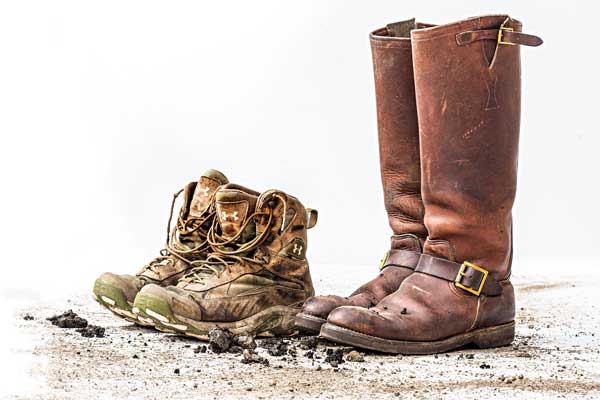 Natural fibers
Natural fibers
Natty Bumppo was nicknamed Leather-stocking for a reason. He wore deerskin britches made from a buck he killed himself. And while leather may have gone out of favor for everyone except aging rockstars, many other natural materials are still worn by hunters today.
Whether he admits it or not, the hunter who goes afield in oilskin is making a fashion statement, just saying no to less-durable nylon materials. Same goes for woolens, though newer materials and manufacturing techniques have taken away the itch and made the insulating fibers soft against the skin.
Down, too, has gotten an upgrade with waterproof treatments, meaning a rainstorm is no longer a death knell for those wearing feathers.
— Vs —
Modern Materials
Wearing materials plucked from the Final Frontier — and we don't mean Alaska — the space-age hunter has technology on his side. Modern materials are able at once to be completely waterproof, yet still breathable, so hunters stay comfortable on long, hot hikes in the rain and snow.
Moisture-wicking materials keep skin dry, while synthetic insulations are lighter and warmer than they've ever been. Hardware, too, has gotten an upgrade, with zippers that are waterproof and snaps that are silent so as to not spook game. Slimmer cuts and strategic designs eliminate that Stay Puft Marshmallow Man look and fit.
One thing that hasn't changed: Fashion still matters, probably even more so today when logos sell more clothing than the actual features do.
Perspective
Take a look at the Cabela's catalog — natural materials are in again. Without exception, merino wool is still the best base layer, and new waterproofing treatments are helping down make a comeback as the warm, lightweight insulation of choice.
However, when it comes to shell materials, synthetic laminates are lighter, quieter, more waterproof, and all-around better than oilskin.
The wise hunter will look beyond the marketing hype and build a clothing system accordingly, but whatever material he chooses, it's still smart to live by one cardinal rule: cotton kills.
Firemaking
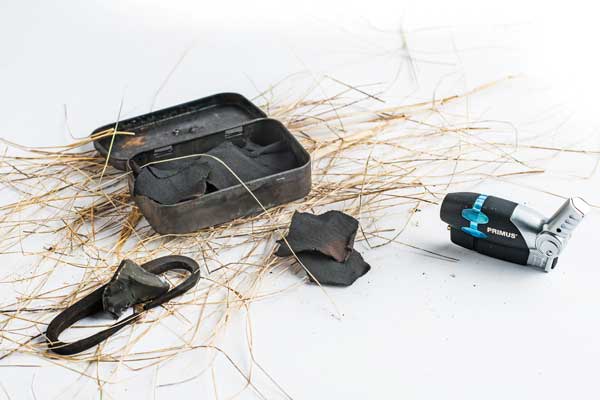 Flint & Steel
Flint & Steel
With a piece of flint and a bit of steel, along with cattail down and pine resin, the woodsman walks confidently into the field ready for anything, knowing a crackling campfire is just a spark away.
Barring flint, he builds a bow drill from tree limbs and cordage, spinning his way to fire, or, at the very least, works up enough body heat trying to warm up.
Going even further back in history, the ancient hunter knew carrying fire was easier than building it, so he packed away a glowing ember wrapped tightly, ready to grow into a flame with the addition of tinder and a few well-directed breaths.
— Vs —
Lighter
The modern hunter with a lighter or waterproof matches in his pocket and a firetab in his pack should be all but guaranteed a fire anytime, anywhere.
Add in the convenience of liquid accelerants, better known as a Boy Scout's best friend, and a flick of the thumb produces not just a spark, but a sustained flame capable of igniting all but the wettest of wood.
Of course, used carelessly, there's also the likelihood of a trip to the burn unit, but, as a generation more concerned about self-help than survival skills likes to say, with great risks come great rewards.
Perspective
Always mind the most important rule of survival and carry at least three ways to start fire while hunting. Matches, lighters, and a spark igniter all qualify, and at least one, along with some type of tinder, should always be carried in a shirt or pants pocket and not in a pack that could become lost.
Still, Murphy's Law applies, and the skill to start a fire without matches or a lighter could save a life or, at the very least, make an unplanned night spent in the woods more comfortable.
Rangefinding
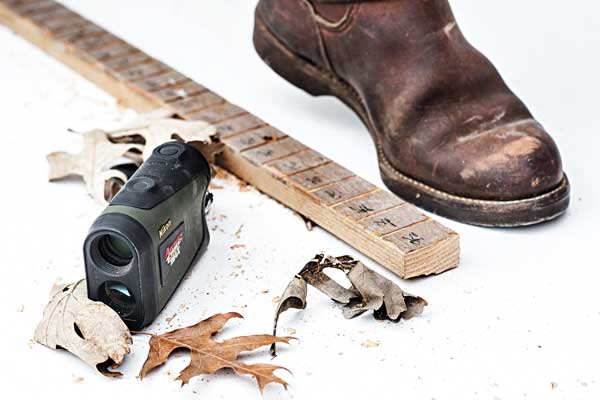 Reading Distance
Reading Distance
Hunters from previous generations didn't have the luxury of an electronic rangefinder. Instead, he was constantly eyeballing distance — and not just when he had a bow or rifle in his hands. On the walk to work, he guessed ranges, confirming them by counting his paces.
He also made mental notes of known distances — the height of a telephone pole or length of a football field — and imagined them laid end to end to the animal. He knew the average size of the animal he was hunting, estimating range within his scope or sights in relation to the measurement from the top of the back to its brisket.
— Vs —
Electronic Rangefinders
Today, a hunter with the push of a button can instantly know a deer is 278 yards away. The size of a deck of cards, next-generation rangefinders can provide an exact point of aim for the cartridge the hunter is shooting and, for the archer, even display the highest arc of his arrow for threading a shot through tight brush.
It can tell where to hold when shooting uphill or downhill and at distances most hunters have no business shooting. For the steady shot, a rangefinder virtually eliminates any excuse for missing, and the technology is even built into binoculars, scopes, and bowsights.
Perspective
In the field, hunters should use an electronic rangefinder whenever possible to ensure the most accurate and ethical shot. The rest of the year, constant practice judging distance visually with electronic confirmation will make snap-shots easier and ensure a killing shot in those instances a trophy appears out of nowhere, leaving the hunter no time to range it electronically.
Predator Calling
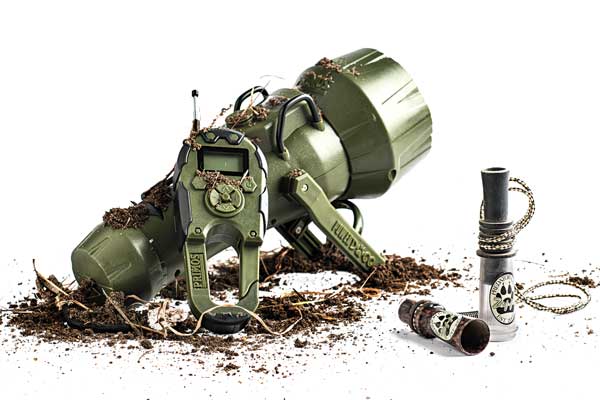 Mouth Calls
Mouth Calls
Not so long ago — just a few years, in fact — every predator hunter worth his fur wore an open-reed mouth call on a lanyard around his neck. He probably had another one or two, along with a closed-reed call, in a nearby pocket.
Much to the annoyance of his spouse, he spent all year practicing with each of them so that at the first set of the season he could go from a jackrabbit squeal to a cottontail in distress to the squeak of a mouse without so much as an extra breath.
With the same call he could make a bobcat squall or the yip of a whipped pup and, with the addition of an old cow horn, set every coyote in the county on notice with a convincing howl.
— Vs —
E-callers
Believe everything you read and you could become convinced anyone with a squawk box full of batteries and a chunk of fur on a spring-loaded stick can call in a coyote.
Truth be told, even equipped with an electronic caller, the fur hunter is facing the ultimate challenge of trying to lure an animal that survives at the top of the food chain.
Still, with a thousand high-definition calls at his fingertips, today's predator hunter does have it easier, dialing through everything from a human baby bawling to — our personal favorite for pranks — the howling housecat-in-heat or about any other sound you can imagine.
Most e-callers today aren't content with just providing sound, but movement as well, with what amounts to a stuffed-animal spinning to seal the deal on wary predators.
Perspective
Though they might not admit it in public, even the most grizzled of fur traders has an e-caller tucked under the seat of his hunting truck. They're just too versatile to ignore and can make the difference between punching hair and going home with the tail tucked between the legs.
But that mouth call still hangs around his neck to provide a finishing note when needed or to fill in holes found in hi-def recordings. Besides, with every amateur out there carrying an e-caller, that mouth call might just give well- educated predators something they've never heard before.
Aiming Method
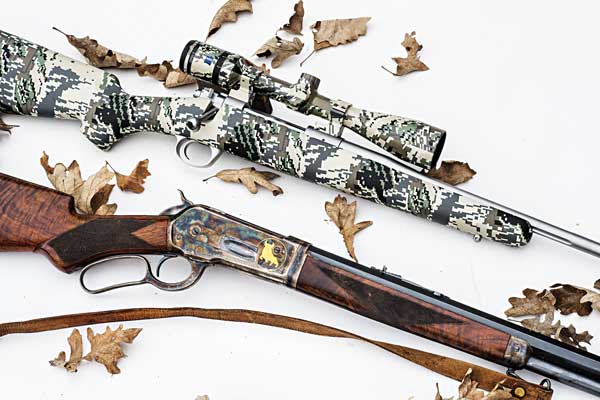 Iron
Iron
Romantic is the notion of the prairie hunter, his heavy-barreled rifle propped into the cross-sticks as he squints through the peep sights at a far-off buffalo.
His accuracy is near-mythical, as was his ability to wipe out entire herds of animals from one stand, but whether or not those stories are true, it's likely an experienced plainsman could outshoot today's average optics-assisted shooter.
Much of that ability comes from practice and the intimate knowledge of how a rifle shoots. He knew to center the post in the peep, rather than bury it at the bottom of the circle, or, with traditional open sights, not to cover the target, but instead place it atop the front blade. Though impervious to the elements, open sights can be hard to adjust perfectly.
— Vs —
Optics
Equipped with a high-quality scope and matched rifle, a modern hunter is almost sniper-like. With lots of practice and an understanding of his capabilities (and limits), he is able to ethically kill animals at incredible distances.
In dark timber, where he's likely to jump a buck at his feet, he knows to dial his scope down for the widest possible field of view, and when hunting the open country of the West, he can up the magnification to nearly pick the very hair he plans to split on his target.
Today's scopes offer today's hunters with any number of crystal-clear sight pictures, from standard duplex crosshairs to electronic dots to ballistic-compensating reticles measured in mil-dots or, yes, even inches to compensate for both drop and wind drift.
Perspective
When it comes down to it, sights are all about personal preference. A hunter whose nerves are amplified by the magnified crosshairs bouncing wildly may be able to cut playing cards with a peep sight, while aging hunters may struggle to keep everything in focus with open sights.
In short, hunters should be proficient with each. Particularly, those who prefer a scoped rifle should at least practice with open sights in the not-so-unlikely event their optics should break in the field.
Either way, accurate shooting is less about what sights are used and more about measured breathing, steady holds, and trigger control.
